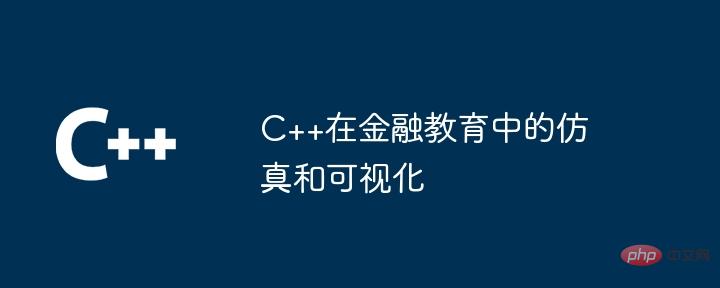Home >Backend Development >C++ >Simulation and visualization of C++ in financial education
Simulation and visualization of C++ in financial education
- WBOYWBOYWBOYWBOYWBOYWBOYWBOYWBOYWBOYWBOYWBOYWBOYWBOriginal
- 2024-06-01 09:56:57813browse
In financial education, C++ can be used for simulation and visualization to help students understand complex concepts. Simulation can be used to explore financial models, such as simulating option prices by implementing the Black-Scholes model in C++. Visualization can be used to present and analyze financial data, such as tracking stock price trends by drawing charts using C++. In practical applications, investment firms use C++ to evaluate the risk and return of investment portfolios, make informed decisions, maximize returns, and manage risk.

#C++ Simulation and Visualization in Financial Education
In financial education, simulation and visualization are critical to helping students understand complex concepts. By using programming languages like C++, educators can create interactive programs that allow students to explore and manipulate financial models.
Black-Scholes Model Simulation
As a classic example in financial simulation, the Black-Scholes model is used to price European options. We can implement this model using C++ and allow students to adjust input parameters such as stock price, volatility, and duration and observe the impact on option prices.
#include <cmath>
#include <iostream>
double BlackScholes(double S, double K, double r, double sigma, double t) {
double d1 = (log(S / K) + (r + sigma * sigma * 0.5) * t) / (sigma * sqrt(t));
double d2 = d1 - sigma * sqrt(t);
return S * normcdf(d1) - K * exp(-r * t) * normcdf(d2);
}
int main() {
double S = 100.0, K = 105.0, r = 0.05, sigma = 0.2, t = 1.0;
std::cout << "期权价格:" << BlackScholes(S, K, r, sigma, t) << std::endl;
return 0;
}Financial Data Visualization
Visualization plays a vital role in displaying and analyzing financial data. We can use C++'s built-in plotting library or third-party libraries to create charts and dashboards that enable students to explore trends, patterns, and relationships.
#include <iostream>
#include <vector>
#include <matplotlibcpp.h>
using namespace std;
namespace plt = matplotlibcpp;
int main() {
vector<double> x = {1, 2, 3, 4, 5};
vector<double> y = {2, 4, 5, 4, 2};
plt::plot(x, y);
plt::xlabel("时间");
plt::ylabel("股票价格");
plt::title("历史股票价格");
plt::show();
return 0;
}Practical Case
An investment firm is using C++ simulation and visualization to evaluate the risk and return of an investment portfolio. They use the Black-Scholes model to predict option prices and track portfolio performance using charts and dashboards. Such tools enable companies to make informed decisions, maximize returns and manage risks.
The above is the detailed content of Simulation and visualization of C++ in financial education. For more information, please follow other related articles on the PHP Chinese website!

